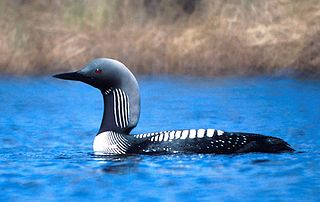
Gaviiformes is an order of aquatic birds containing the loons or divers and their closest extinct relatives. Modern gaviiformes are found in many parts of North America and northern Eurasia, though prehistoric species were more widespread.

Loons or divers are a group of aquatic birds found in much of North America and northern Eurasia. All living species of loons are members of the genus Gavia, family Gaviidae and order Gaviiformes.

The red-throated loon or red-throated diver is a migratory aquatic bird found in the northern hemisphere. The most widely distributed member of the loon or diver family, it breeds primarily in Arctic regions, and winters in northern coastal waters. Ranging from 55 to 67 centimetres in length, the red-throated loon is the smallest and lightest of the world's loons. In winter, it is a nondescript bird, greyish above fading to white below. During the breeding season, it acquires the distinctive reddish throat patch which is the basis for its common name. Fish form the bulk of its diet, though amphibians, invertebrates, and plant material are sometimes eaten as well. A monogamous species, red-throated loons form long-term pair bonds. Both members of the pair help to build the nest, incubate the eggs, and feed the hatched young.
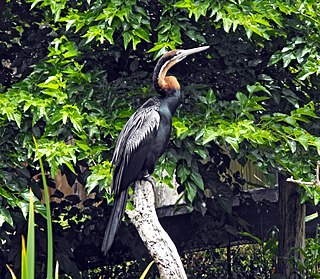
The darters, anhingas, or snakebirds are mainly tropical waterbirds in the family Anhingidae, which contains a single genus, Anhinga. There are four living species, three of which are very common and widespread while the fourth is rarer and classified as near-threatened by the IUCN. The term snakebird is usually used without any additions to signify whichever of the completely allopatric species occurs in any one region. It refers to their long thin neck, which has a snake-like appearance when they swim with their bodies submerged, or when mated pairs twist it during their bonding displays. "Darter" is used with a geographical term when referring to particular species. It alludes to their manner of procuring food, as they impale fishes with their thin, pointed beak. The American darter is more commonly known as the anhinga. It is sometimes called "water turkey" in the southern United States; though the anhinga is quite unrelated to the wild turkey, they are both large, blackish birds with long tails that are sometimes hunted for food.

Phalacrocoracidae is a family of approximately 40 species of aquatic birds commonly known as cormorants and shags. Several different classifications of the family have been proposed, but in 2021 the IOC adopted a consensus taxonomy of seven genera. The great cormorant and the common shag are the only two species of the family commonly encountered in Britain and Ireland and "cormorant" and "shag" appellations have been later assigned to different species in the family somewhat haphazardly.
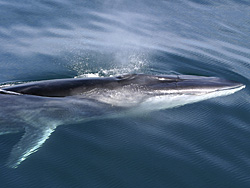
Balaenoptera is a genus of rorquals containing eight extant species. Balaenoptera comprises all but two of the extant species in its family ; the genus is currently polyphyletic, with the two aforementioned species being phylogenetically nested within it.

The black geese of the genus Branta are waterfowl belonging to the true geese and swans subfamily Anserinae. They occur in the northern coastal regions of the Palearctic and all over North America, migrating to more southernly coasts in winter, and as resident birds in the Hawaiian Islands. Alone in the Southern Hemisphere, a self-sustaining feral population derived from introduced Canada geese is also found in New Zealand.
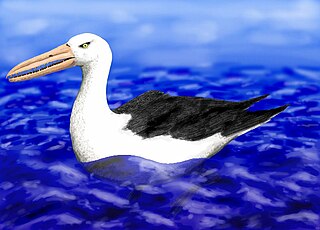
Osteodontornis is an extinct seabird genus. It contains a single named species, Osteodontornis orri, which was described quite exactly one century after the first species of the Pelagornithidae was. O. orri was named after then-recently deceased naturalist Ellison Orr.
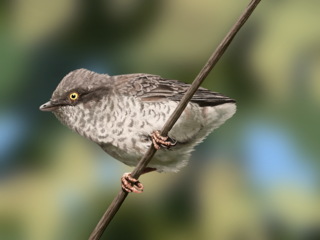
Alexornis is a genus of enantiornithine birds from the Bocana Roja Formation of Baja California, Mexico. This geological formation has been dated to the late Cretaceous period, and more specifically to the Campanian age, about 73 mya. The type and only known species is Alexornis antecedens. Its name means "Alex's ancestral bird"; Alexornis from the given name of ornithologist Alexander Wetmore + Ancient Greek ornis, "bird", and antecedens, Latin for "going before" or "ancestral".

The Pelagornithidae, commonly called pelagornithids, pseudodontorns, bony-toothed birds, false-toothed birds or pseudotooth birds, are a prehistoric family of large seabirds. Their fossil remains have been found all over the world in rocks dating between the Early Paleocene and the Pliocene-Pleistocene boundary.
The San Diego Formation is a geologic formation in southwestern San Diego County in southern California, and northwestern Baja California (México).
Cyphornis is a genus of the prehistoric pseudotooth birds. These were probably rather close relatives of either pelicans and storks, or of waterfowl, and are here placed in the order Odontopterygiformes to account for this uncertainty.

Dasornis is a genus of the prehistoric pseudotooth birds. These were probably rather close relatives of either pelicans and storks, or of waterfowl, and are here placed in the order Odontopterygiformes to account for this uncertainty.

Pelagornis is a widespread genus of prehistoric pseudotooth birds. These were probably rather close relatives of either pelicans and storks, or of waterfowl, and are here placed in the order Odontopterygiformes to account for this uncertainty.
Pseudodontornis is a rather disputed genus of the prehistoric pseudotooth birds. The pseudotooth birds or pelagornithids were probably rather close relatives of either pelicans and storks, or of waterfowl, and are here placed in the order Odontopterygiformes to account for this uncertainty. Up to five species are commonly recognized in this genus.
Tympanonesiotes is a somewhat doubtfully valid genus of the prehistoric pseudotooth birds. These were probably rather close relatives of either pelicans and storks, or of waterfowl, and are here placed in the order Odontopterygiformes to account for this uncertainty.

Gavia schultzi is an extinct species of loon from the Middle Miocene of Austria. It is amongst the oldest known species in the genus and larger than the older Gavia egeriana from the Early Miocene Czech Republic.
Gaviella is an alleged North American Paleogene gaviiform which the holotype consists of the proximal end of a left carpometacarpus from Wyoming, United States. However, Shufeldt mentioned the location and the age of the fossil was not recorded by J.B. Hatcher and his team who collected it. Shufeldt originally classified this taxon as a species of the living genus Gavia being half the size of the common loon due to some similarity of the carpometacarpus of the aforementioned extant species. In 1940 Wetmore argued the specimen is distinctive enough to, not only belong to its own genus which named Gaviella, but also felt they belong to their own subfamily Gaviellinae. This lead him to believe the specimen originated from the White River Formation.
Phoenicopterus floridanus is an extinct species of flamingo that lived during the Pliocene in what is now Florida and potentially North Carolina.










